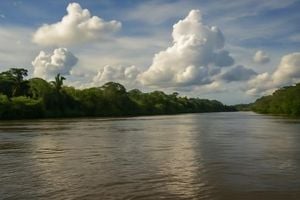The recent collapse of the iconic Double Arch at Glen Canyon National Recreation Area has sparked significant concerns about safety and stability across national parks. The Double Arch, known for its breathtaking structure, fell victim to natural erosion, reminding visitors of the sometimes precarious nature of geological wonders.
Formed from 190-million-year-old Navajo sandstone, this remarkable arch was located near Rock Creek Bay, roughly 36 miles from Antelope Point Marina. Its collapse occurred dramatically as visitors were present, prompting them to question the safety of other popular formations like Utah's Delicate Arch.
Many nature lovers are wondering, is it safe to admire such arches? The truth is, all natural arches are vulnerable to the same forces of nature, including weathering and gravity, which can lead to their eventual breakdown.
The National Park Service (NPS) is dedicated to preserving these natural features, emphasizing the need to respect their processes. Rather than artificially stabilizing arches, the NPS focuses on monitoring these geological structures to maintain visitor safety.
One key element of ensuring safety is conducted by the Northern Colorado Plateau Network, which oversees multiple parks, including Arches National Park. This network diligently tracks various environmental factors affecting the stability of more than 2,000 documented arches, which vary from narrow cracks to expansive spans.
The NPS monitors indicators like air quality, vegetation, and land surface dynamics as part of their efforts to assess each park's health. They take these measures seriously, closing areas beneath arches when signs indicate potential instability.
Truly, these formations are not just rocks but historical markers, representing the Earth's geological history. Their transient nature calls for appreciation from safe distances and thoughtful interactions with the surrounding environment.
And how can visitors safely enjoy these beautiful landmarks? It's recommended they remain on designated trails, heed all warnings, and avoid climbing on or near arches to minimize risks.
Moving beyond the collapse of the Double Arch, the broader challenge of managing national park safety is apparent. An increase of visitors to U.S. national parks brings about new levels of risk, particularly when people engage recklessly with wildlife.
For example, Jackson Hole, Wyoming, near Grand Teton and Yellowstone National Parks, has been addressing dangerous behaviors among tourists. Local officials introduced "Selfie Control," an innovative app aimed at keeping tourists at safe distances from wildlife, helping prevent dangerous encounters.
Selfie Control superimposes images of animals like moose or bears, allowing users to gauge their distance. One official noted, “It’s hard to tell if an animal is 25 or 100 yards away, especially when the scenery is vast and open.”
The app provides practical tips, reminding users just how fast certain animals, like grizzly bears, can run. This serves as both instruction and warning for tourists tempted to venture too close for memorable photos.
Despite the technological initiatives, reckless behavior continues to plague national parks. From petting wild animals to attempting selfies with dangerous wildlife, many visitors have made headlines for their poor decisions.
While these encounters are often sensationalized on social media, fatalities due to wildlife remain rare. Most deaths within national parks typically result from vehicle accidents, falls, and drownings.
It's on the visitors to follow proper protocols for safety and respect for wildlife. The National Park Service suggests maintaining safe distances and using cameras with zoom features rather than closing the gap.
When discussing the increasing numbers of visitors to national parks, one cannot overlook the influence of social media. A growing number of people are inspired to visit parks after seeing stunning images online, resulting in record visitation numbers.
For example, the popularity of locations such as Half Dome in Yosemite has surged, leading to discussions on safety, particularly following the tragic death of Grace Rohloff. The popularity of social media is undoubtedly linked to the decision of parks to implement measures like permit lotteries to manage crowd levels.
Half Dome’s steep ascent draws thousands each year, and applications for permits have risen dramatically. With over 35,000 applications filed recently, the challenge lies not just with the increasing number of visitors but ensuring their safety on such demanding hikes.
The Rohloff family, experienced hikers, know the challenges all too well. Following the loss of Grace, her father Jonathan pointed out the need for potential improvements to safety measures on steep descents.
Some argue for more natural approaches to enhancing safety, focusing on preserving the park's character. Jonathan believes simple adjustments like additional wooden slats could help improve navigation without compromising the setting.
Many see social media’s role as double-edged; it encourages exploration yet often draws unprepared individuals to perilous trails. Hiking expert Cris Hazzard highlights the necessity for proper judgment before embarking on nature’s challenges.
While the allure of social media and stunning landscapes is undeniable, each visitor must prioritize safety above all else. Educators and enthusiasts alike stress preparation as key to ensuring safe and enjoyable excursions to national parks.
Those adhering to guidelines and respecting the power of nature can continue to appreciate these marvels safely. The importance of gratitude for our natural environment remains central, especially at times of uncertainty following events like the Double Arch collapse.
It is both thrilling and sobering to witness nature’s beauty, reminding everyone of the delicate balance between enjoyment and awareness. Moving forward, national parks must adapt to both the influx of visitors and the challenges presented by our changing environment, all with safety and preservation as core priorities.



